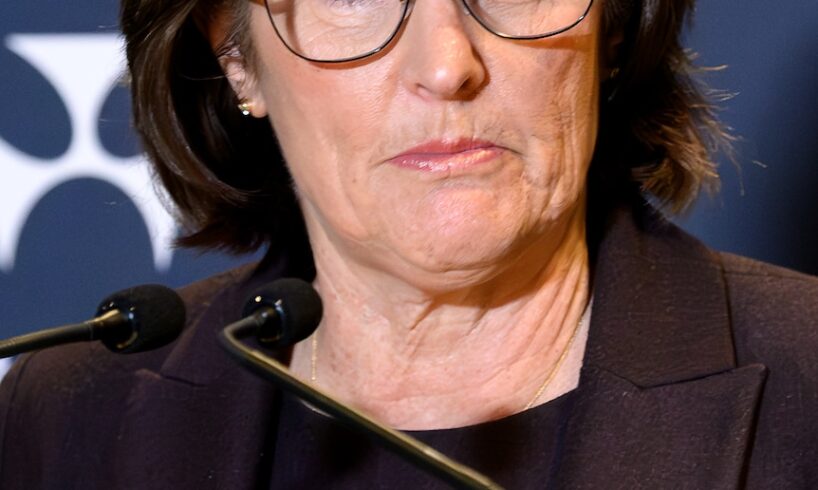
They say hindsight is 20-20, but three members of the Reserve Bank board are likely to turn up at the next meeting with the strong temptation to say, “we told you so”.
The RBA has released the minutes from its meeting two weeks ago, when interest rates were left on hold, catching the market and most private-sector economists off guard.
That decision to keep rates steady was made by a six to three majority, with the minority arguing there was no need to wait.
“The case to lower the cash rate target at this meeting rested on a view that there was already sufficient evidence to be confident that inflation was on track to be sustainably back at the midpoint of the target range, if not lower,” the minutes revealed.
“This implied less need to wait before easing policy further, which was a relevant consideration given the lags in the effect of monetary policy on economic activity and inflation.”
The minority in favour of a cut argued that US tariff policy would be a drag on future global economic growth, that Australia’s economic expansion remained “subdued”, households were saving more, wages growth and services inflation were weakening, and that “recent data suggested a loss of momentum in activity”.
“Moreover, there was uncertainty around whether market sector employment growth would increase by enough to offset an expected slowing in non-market sector employment growth to maintain momentum in overall employment growth,” the minutes showed.
That last concern appears to have since been vindicated by another weak set of jobs numbers, released last week, showing unemployment had jumped from 4.1 per cent in May to 4.3 per cent in June, seasonally adjusted, although some analysts have attributed the scale of that increase to statistical variation.
Loading…
RBA does not record who voted which way
While the Reserve Bank published the number of votes for and against a rate cut at its July meeting, it did not publish the names of those who voted for and against.
The Reserve Bank Act 1959, recently amended following a review of the RBA, does not require this, nor does it even compel the bank to disclose the dispersion of votes — the decision to do so was one made by the board itself, acting on one of the recommendations of that review.
Some overseas central banks, including the US Federal Reserve and Bank of England, do publish attributed votes from their monetary policy meetings.
The Reserve Bank Act does not even require the board to publish its minutes, although it has historically done so, and the legislation gives the board very wide scope to manage its affairs and run its meetings as it sees fit.
A Freedom of Information (FOI) request from ABC News has revealed that the RBA board does not even maintain a formal written record of who voted which way on the question of what to do with interest rates.
The ABC asked for a “document recording the names of the Monetary Policy Board members who voted a) for and b) against the decision of the board to leave the cash target rate unchanged at its meeting on 8 July 2025.”
The formal response from the RBA’s secretary, Anthony Dickman, was revealing.
“We have undertaken a search of our records and have not been able to identify any documents relevant to your request,” he responded.
“No document was created that recorded by name any vote cast by members of the Monetary Policy Board.”
Mr Dickman said he checked widely with relevant RBA staff who were present at the meeting to see if anyone had kept a record of who voted which way.
“Reserve Bank staff (i.e. the governor, deputy governor, secretary and deputy secretary) who potentially could have recorded the information you sought into a document were asked to provide any such document in their possession that fell within the scope of your request and they all advised they did not possess any such document (no such document was created),” he responded.
This would mean it falls upon the recollections, or personal notes, of individual board members to know how their colleagues had voted at previous meetings.
More rate cuts coming, but timing in question
At her post-meeting press conference, RBA governor Michele Bullock said the disagreement among the board was not one of where rates should head, but merely the timing of further rate cuts.
This is reflected in the formal minutes from the meeting.
“All members agreed that, based on the information currently available, the outlook was for underlying inflation to decline further in year-ended terms, warranting some additional reduction in interest rates over time,” the minutes noted.
“The focus at this meeting was on the appropriate timing and extent of further easing, against the backdrop of heightened uncertainty.”
The majority who decided to keep interest rates on hold based their decision on a few key elements.
How much will the RBA cut rates in August?
Unlike the minority, most board members interpreted recent economic data as surprisingly upbeat, including the very monthly inflation figures that had prompted some market economists to bring forward their rate cut forecasts from August to July.
“Monthly indicators of inflation had been marginally higher than were consistent with the staff’s forecast for underlying inflation in the June quarter, growth in private demand in the March quarter had been a little stronger than expected and conditions in the labour market had so far not eased as anticipated,” the majority argued.
They also said that global economic outcomes had so far been more benign than feared at the previous May meeting, when rates had been cut, reducing the urgency for another rate cut.
“Members noted that the baseline forecasts already incorporated some deterioration in global economic conditions because of higher tariffs and policy uncertainty, which was consistent with the evidence currently available on how the trade tensions and other factors might be resolved,” the minutes revealed.
“Moreover, the forecasts had been conditioned on a relatively modest and gradual path of further easing of monetary policy over the period ahead.”
RBA adopts ‘cautious and gradual’ strategy on rates
After two rate cuts, the majority of the board was also concerned that it would be difficult for the RBA to know exactly when monetary policy had changed from being restrictive — that is, holding back economic growth — to neutral or boosting activity.
Given the degree of uncertainty around what the current “neutral” level of the cash rate is, the majority argued that “lowering the cash rate a third time within the space of four meetings would be unlikely to be consistent with the strategy of easing monetary policy in a cautious and gradual manner”.
While the majority of RBA board members wanted to pause on cutting rates, a minority dissented. (AAP: Paul Miller)
CBA economist Belinda Allen noted that the level of caution from the majority of the board, as expressed in the minutes, keeps in doubt what the market has assumed is a certain rate cut in August.
“Market pricing for an August rate cut is over 100 per cent priced. But it is not a done deal,” she wrote.
“Our base case is for a 25-basis-point rate cut in August as long as the annual trimmed mean CPI [Consumer Price Index] continues to moderate from its current rate of 2.9 per cent.
“We expect another rate cut in November with the risk of an additional cut in early 2026.”
Despite the expressed caution of the majority on the RBA board, Abhijit Surya from Capital Economics expects rates to fall at next month’s meeting on August 11-12, with further cuts to follow.
“With the unemployment rate having surged in June and timely indicators suggesting that activity and inflation both remain subdued, the bank will almost certainly resume its easing cycle in August,” he noted.
“Looking further ahead, we expect the board to cut rates to 2.85 per cent by mid-2026, in line with the bank’s stated goal of ensuring that monetary policy is no longer restrictive.
“Our terminal rate forecast is below the 3.1 per cent currently predicted by the analyst consensus.”
Either way, that implies between three and four more rate cuts from the current cash rate of 3.85 per cent, unless the market has again misread the degree of caution among the majority of RBA board members.





